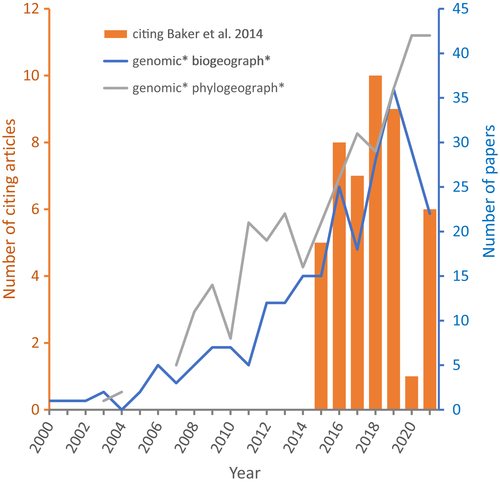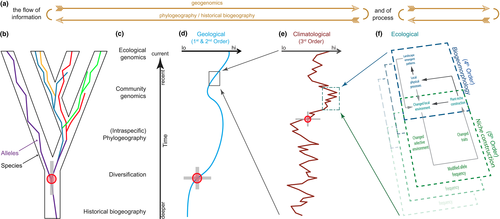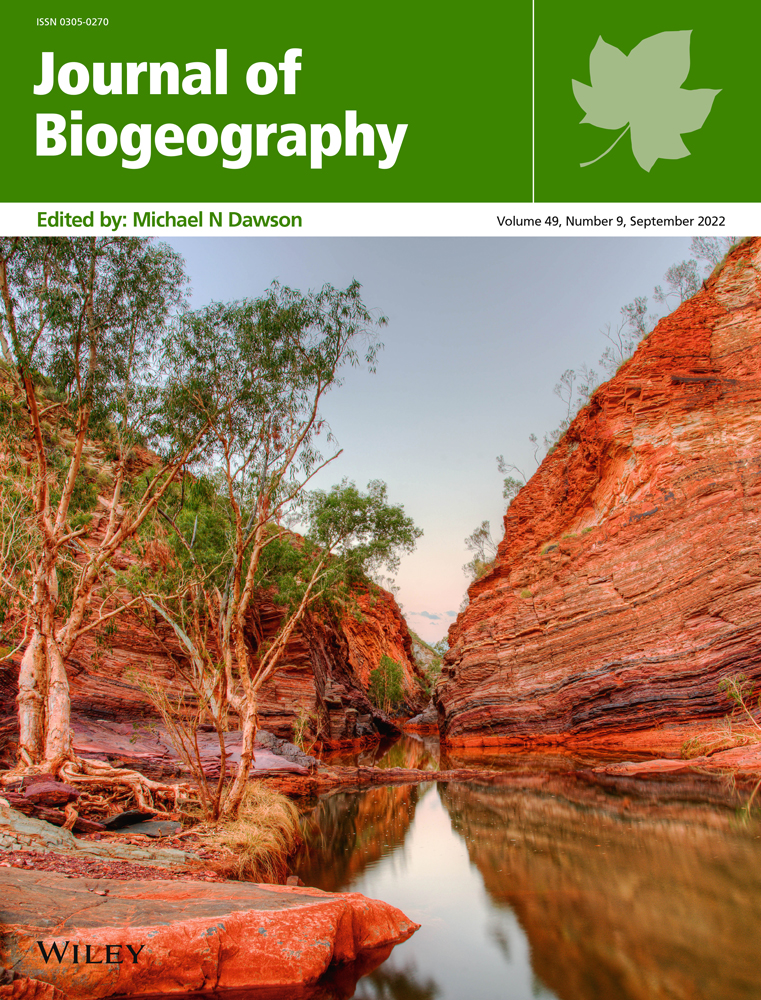Geogenomics: Toward synthesis
Handling Editor: Cynthia Riginos
Ours is an often integrative undertaking, a discipline peppered with combinatorial neologisms that reflect the formation and advances of practice and of thought: bio·geography, phylo·geography (Avise et al., 1987) and macro·ecology (Brown & Maurer, 1989), for example. When coined, these new words described an idea—perhaps a technologically enabled way of asking new questions, as in the case of phylogeography, or a novel way of conceptualizing existing data, as in macroecology—in the previously inaccessible interstices or remote reaches of existing thought. In the earliest stages, the idea is rare, precariously placed, and has an uncertain future; it is only assured a place in history if the approach and its contributions are sufficiently accessible and insightful that the principles are adopted more broadly. Adoption and growth is at first slow, but if intriguing and fruitful, the approach will spread and the new field will gain critique and refinements as it develops and matures. Such has been, of course, the fate of the two examples mentioned here. And in time they may go on to seed additional fields.
A more recent neologism is geo·genomics (Baker et al., 2014). While drawing on similar etymons, the origins of geogenomics and phylogeography emphasize distinct characteristics. Whereas phylogeography originated with innovations in molecular biology—specifically the techniques that made mtDNA widely accessible—at the intersection of population genetic and phylogenetic thought, geogenomics' core idea lies in interdisciplinary approaches. Although geogenomics eponymously acknowledges advances in high-throughput sequencing that enabled sampling the breadth of genetic information in organisms, its intersection with geographical and geological thinking is the source of novelty in geogenomics hypothesis testing. As defined by Baker et al. (2014), geogenomics was conceived as ‘the use of large-scale genetic data to test or to constrain geological hypotheses … through collaboration between geologists and evolutionary biologists’. They saw it as being ‘deeply rooted in … biogeography’ and ‘(1) providing an independent chronology for a variety of past geologic events, some of which may be otherwise extremely difficult or impossible to date, and (2) providing constraint and nuance to paleo-environmental interpretations’. While geogenomics, thus, was established with an emphasis on the flow of information from biology to geology, that is, in testing geological hypotheses using genomic data (Baker et al., 2014), it nonetheless recognized the value of reciprocal illumination (sensu Hennig, 1966). In a biogeographical context, reciprocal illumination was understood to mean that hypotheses to be tested using the biological (genomic) datasets would be built using detailed knowledge about geological processes; that is, hypotheses would be realistically framed in space and time and their mechanistic outcomes would be well understood by both biologists and geologists.
Intriguingly, Sargeant et al. (2014) also coined the term ‘geogenomics’ but from a very different perspective, specifically the geography of pathogens, and emphasizing finer spatial and temporal scales. Sargeant et al. (2014) defined geogenomics as the ‘examin[ation of] the geographic distribution of … genomes … with a particular emphasis on those mutations that give rise to [adaptations]’; their vision of geogenomics was an extension of evolutionary biology, historical and phylogenetic biogeography, and phylogeography. The differences between these two visions—one explicitly hypothesis driven (Baker et al., 2014), and the other largely descriptive (Sargeant et al., 2014)—and their fates are perhaps illuminating: Baker et al. (2014) has been well cited (Figure 1), whereas Sargeant et al. (2014) has been cited only once. Geogenomics sensu Baker et al. (2014) brought something new, something for which phylogeography had long been critiqued as lacking (Nielsen, 2006), that is, a focus on rigorously articulating causal mechanisms linking the coupled evolution of biodiversity and landscapes through time (Dolby et al., 2022; see also Dong, 2022; Figure 2).


One of the great potentials of genomic data is providing information about ecological and evolutionary processes across a range of timescales, so one may be able to look at the interaction of geology with biology, and biology with geology. The continuity of ecological and evolutionary processes has long been appreciated (Marske et al., 2013), but geogenomics arguably extends this further, considering how geological and evolutionary relationships can be nested in time and recorded as superimposed signals in the record of each (Figure 2). At the deep-time end of the spectrum, such things are the purview of classical historical (phylogenetic) biogeography and include questions surrounding Gondwanan vicariance, uplift of the Andes (and every other mountain chain), emergence of the Isthmus of Panama and so on. At the shallowest time spectrum, it includes allele frequency distributions that may hold information about generational changes, including changes in connectivity and diversity of populations responding to landscape and anthropogenic change and the evolution of plant niche construction traits in biogeomorphic landscapes (Dong, 2022), wherein mutual feedbacks over short times may structure both biotic and abiotic environments. These processes must occur on ecological scales throughout evolutionary time (Marske et al., 2013), leading to questions of eco-evolutionary meandering (Thompson, 1999), and the extent to which large-scale interspecific biogeographical patterns are ineluctably extrapolations of small-scale population-level biogeographical processes (Avise et al., 1987). But how biogeographical processes scale—from local microevolutionary processes to regional macroevolutionary patterns—is something we still do not know, and must yet become tractable as genomic and geological information become better integrated, and as in situ and remotely sensed data become more available on finer scales and more continuously through time and across places. If geogenomics can provide a robust framework for integrating such diverse data streams, perhaps it can precipitate a truly synthetic biogeography?
It is in this spirit of development and refinement of a still young (only 8 years!) and emerging field that we invited contributions to a collection of papers at the intersection of geology, geobiology, earth system science, genomics and higher-level biodiversity studies. Through an expansion of its original definition, we explicitly targeted the potential for geogenomics to yield reciprocal illumination (Hennig, 1966), noting that ‘Geogenomics employs genomic data to solve geologic problems or constrain geological hypotheses … [and that] phylogenetics and phylogeography seek to use the geological record … for formulating diversification hypotheses’. Improving mutual appreciation of limits and opportunities within explicit frameworks is key. In interdisciplinary scientific pursuits, it is easy to understand nuances and uncertainties in one's own field, but to presume greater certainty in another. Yet uncertainty, like the processes it describes, is distributed heterogeneously; absolute uncertainty is generally higher on deep timescales and lower (but rarely absent) on recent timescales. Yet a ‘coefficient of uncertainty’, as an analogue of the ‘coefficient of variance’, would suggest that uncertainty remains substantial at many scales: reconstructions of the palaeogeographical history of the Amazon are imprecise, as are predictions of gene flow from marine larval transport. Better constraining such uncertainties will enable more mechanistic integration across all scales and beckons a unified and intersectional approach—looking from deep time forward, and from contemporary time backward—where mutual strengths are combined to inform the hypothesis-space and leverage a synergistic understanding of the dynamic, sometimes deterministic and sometimes stochastic, world.
We publish the first papers in the geogenomics special collection here to explore some of these matters. Our goal is to provide a sampling of what geogenomics is currently perceived to be (and therefore what it is?) and also to drive advancement in this synthetic field. This section begins with six papers that examine genetic structure in fish, insects, plants and birds, including studies rooted in Africa, Australia, Eurasia and South America. Several papers examine how the genetic structure of populations is related to changes in landscape structure driven by Quaternary climate variability. Luna et al. (2021) use explicit hypothesis testing to discover that the genetic differentiation in an endemic bird of the Amazon floodplains is related to changing connectivity of drainages associated with Pleistocene climate change, instead of strong gradients in contemporary environmental or river characteristics. Similarly, Barbosa et al. (2021) show that floodplain habitats differing in long-term persistence and connectivity led to different demographic histories for sympatric ovenbird species with distinct habitat affinities. Changes in connectivity also were inferred to drive genetic diversification in thermophilous grasshoppers in Iberia and North Africa as a result of fluctuating sea level and suitable climate during glacial–interglacial cycles (Ortego et al., 2021), and in a widely distributed migratory freshwater fish in Australia as a result of aridification during Pleistocene glacial periods (Booth et al., 2022). Sanín et al. (2022) reveal that tectonic faulting dynamics, rather than recent mountain uplift, likely shaped phylogeographical breaks in Andean palms. Barthelemy and Munoz (2022) evaluated processes in deeper time and examined whether the proportion of shared lineages of woody plants between India and Madagascar changed following the period of separation and isolation of Madagascar from the Indian-Malagasy plate. Their analysis indicates that Madagascar maintained more of the ancient flora than the Western Ghats of India, likely because of expanded biotic interchange following the collision of India with Eurasia.
What these contributions imply for the future of geogenomics is something to consider again when all the papers in the collection are available. In the meantime, we re-focus briefly on geogenomics' origins in Baker et al. (2014) and the counterpoint of Sargeant et al. (2014) as food for thought. Whereas Sargeant et al. (2014) appeared largely an extension of existing practice, Baker et al. (2014) joined a chorus for updating and extending phylogeography sensu lato (Dawson, 2014; Hickerson et al., 2010; Knowles & Maddison, 2002; Marske et al., 2013; Papadopoulou & Knowles, 2016), and perhaps because Baker et al. (2014) expounded a new core idea and identified a specific audience, it had greater impact. Yet, many papers in the special issue include components that are not encapsulated by the original definition of geogenomics (sensu Baker et al., 2014), as they do not test or constrain specific geological hypotheses, but use geological data to build predictions about biological processes (e.g. demography, migration), often in recent times, thus articulating a finer scale of reciprocal illumination. Is this evidence that geogenomics is misunderstood? Or that it is evolving? Or, perhaps its potential is not yet widely recognized by geologists, and thus that these papers represent a largely biological point of view? Should geogenomics take this opportunity to reaffirm itself as genomics clarifying geology? Or should it broaden its embrace while emphasizing the central tenet of using rich interdisciplinary quantitative data in hypothesis-driven frameworks? Reciprocally? These seem, to us, to be key questions for this special collection to address.
And what of the consequences? Can geogenomics catalyse rethinking of the direction of information flow—not only in biogeography but also in nature—and a revolution in our practice sui generis? Or will the ingrained anecdotal approach to phylogeography prevail, co-opting ‘geogenomics’ simply as shorthand for work that draws on both geo(-logical or -graphical) and genomic datasets but not substantially amending practice? Others have already noted that ‘phylogeography’ may have passed its peak as a term, even if its essence lives on in other guises (Edwards et al., 2021; but see Figure 1). But does it, and, in its current common configuration, should it? Or is it time to reflect fondly on the many advances made by phylogeography while looking now to a different neologism—geogenomics—for better ways to understand the coupled evolution of Life and Earth?
ACKNOWLEDGEMENTS
The authors conceived and edited this special issue with Anna Papadopoulou and Paul Baker, who handled a number of the manuscripts and contributed to conversations about the integration of genetic and geological approaches. Funding included US NSF EAR-1812857 (SCF), EAR-1812681 (PAB), CNPq 311732/2020-8 and FAPEAM/Biodiversa 01.02.016301.01763/2021 (CCR). Permits were not required for this work.
CONFLICTS OF INTEREST
The authors have no conflict of interest.
Open Research
DATA AVAILABILITY STATEMENT
Data for Figure S1 are presented in supplementary online documentation.
REFERENCES
BIOSKETCH
Author contributions: The article was developed, written, edited, and approved by all authors.




